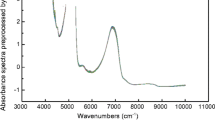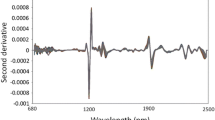Abstract
Improper fermentation of pineapple wine owing to volatile acidity has been associated with excessive proliferation of acetic acid bacteria during fermentation and consequent increased acetic acid concentration. Mid-infrared (MIR) and near-infrared (NIR) spectroscopies were employed to classify improper pineapple wine fermentation. Two clusters of samples possessing within the limit and over-limit acetic acid content were obtained using low-grade pineapples and prepared accordingly. Spectral data were collected for all samples in the 4000–650 cm−1 region using attenuated total reflection (ATR) with an FT-MIR spectrophotometer and in the 11,536–5800 cm−1 using sample vials and 11,536–3952 cm−1 regions using a liquid probe and a liquid cup with an FT-NIR spectrophotometer. The classification models for pineapple wine fermentation based on acetic acid content were constructed using soft independent modeling of class analogy (SIMCA) and partial least squares discriminant analysis (PLSDA). Comparisons of MIR and NIR techniques, classification methods, and spectral pretreatments have been reported. The results demonstrated that MIR spectroscopy coupled with ATR and PLSDA is highly effective for the detection of improper pineapple wine fermentation as a function of acetic acid content. The best classification model was generated using the entire MIR spectra after second derivatives transformation, which provided the highest accuracy, sensitivity, specificity, and precision.
Graphical abstract







Similar content being viewed by others
Data availability
All data generated or analyzed during this study are included in this published article.
References
Attaviroj N, Kasemsumran S, Noomhorm A (2011) Rapid rough rice variety classification by fourier transform near infrared spectroscopy. Cereal Chem 88:490–496. https://doi.org/10.1094/CCHEM-03-11-0025
Boondaeng A, Kasemsumran S, Ngowsuwan K, Vaithanomsat P, Apiwatanapiwat W, Trakunjae C, Janchai P, Jungtheerapanich S, Niyomvong N (2022) Fermentation condition and quality evaluation of pineapple fruit wine. Fermentation 8:11. https://doi.org/10.3390/fermentation8010011
Buick D, Holdstock M (2003) The relationship between acetic acid and volatile acidity. AWRI Tech Rev 143:39–43
Canal C, Ozen B (2017) Monitoring of wine process and prediction of its parameters with mid-infrared spectroscopy. J Food Process Eng 40:e12280. https://doi.org/10.1111/jfpe.12280
Chanprasartsuk O, Pheanudomkitlert K, Toonwai D (2012) Pineapple wine fermentation with yeasts isolated from fruit as single and mixed starter cultures. Asian J Food Agro-Ind 5:104–111
Corison CA, Ough CS, Berg HW, Nelson KE (1979) Must acetic acid and ethyl acetate as mold and rot indicators in grapes. Am J Enol Vitic 30:130–134
Cozzolino D, Kwiatkowski MJ, Parker M, Cynkar WU, Dambergs RG, Gishen M, Herderich MJ (2004) Prediction of phenolic compounds in red wine fermentations by visible and near infrared spectroscopy. Anal Chim Acta 513:73–80. https://doi.org/10.1016/j.aca.2003.08.066
Cozzolino D, Parker M, Dambergs RG, Herderich M, Gishen M (2006) Chemometrics and visible-near infrared spectroscopic monitoring of red wine fermentation in a pilot. Biotechnol Bioeng 95:1101–1107. https://doi.org/10.1002/bit.21067
Cuadros-Rodríguez L, Valverde-Som L, Jiménez-Carvelo AM, Delgado-Aguilar M (2020) Validation requirements of screening analytical methods based onscenario-specified applicability indicators. TrAC Trends Analyt Chem 122:115705. https://doi.org/10.1016/j.trac.2019.115705
Dellacassa E, Trenchs O, Fariña L, Debernardis F, Perez G, Boido E, Carrau F (2017) Pineapple (Ananas comosus L. Merr.) wine production in Angola: Characterisation of volatile aroma compounds and yeast native flora. Int J Food Microbiol 241:161–167. https://doi.org/10.1016/j.ijfoodmicro.2016.10.014
Dini I, Di Lorenzo R, Senatore A, Coppola D, Laneri S (2020) Validation of rapid enzymatic quantification of acetic acid in vinegar on automated spectrophotometric system. Foods 9:761. https://doi.org/10.3390/foods9060761
Drysdale GS, Fleet GH (1988) Acetic acid bacteria in winemaking: a review. Am J Enol Vitic 39(2):143–154
Esbensen KH (2010) Multivariate Data Analysis In Practice, 5th ed.; Camo Software: Oslo, Norway, ISBN-10 8299333032.
Faqeerzada MA, Perez M, Lohumi S, Lee HS, Kim G, Wakholi C, Joshi R, Cho BK (2020) Online Application of a hyperspectral imaging system for the sorting of adulterated almonds. Appl Sci 10:6569. https://doi.org/10.3390/app10186569
Ferreiro-Gonzalez M, Ruiz-Rodriguez A, Barbero GF, Ayuso J, Alvarez JA, Palma M, Barroso CG (2019) FT-IR, Vis spectroscopy, color and multivariate analysis for the control of ageing processes in distinctive Spanish wines. Food Chem 277:6–11. https://doi.org/10.1016/j.foodchem.2018.10.087
Firmani P, Bucci R, Marini F, Biancolillo A (2019) Authentication of “Avola almonds” by near infrared (NIR) spectroscopy and chemometrics. J Food Compos Anal 82:5. https://doi.org/10.1016/j.jfca.2019.103235
Garcia-Hernandez C, Salvo-Comino C, Martin-Pedrosa F, Garcia-Cabezon C, Rodriguez-Mendez ML (2020) Analysis of red wines using an electronic tongue and infrared spectroscopy. correlations with phenolic content and color parameters. LWT 118:108785. https://doi.org/10.1016/j.lwt.2019.108785
Greenshields RN (1978) Acetic acid: vinegar. in primary products metabolism, economic microbiology. Academic Press
Han Y, Du J, Li J, Li M (2019) Quantification of the organic acids in hawthorn wine: a comparison of two HPLC methods. Molecules 24(11):2150. https://doi.org/10.3390/molecules24112150
International Federation of Fruit Juice Producers (IFU) (1986) Determination of total volatile acids, IFU Analysis No.5, Paris.
Kasemsumran S, Boondaeng A, Ngowsuwan K, Jungtheerapanich S, Apiwatanapiwat W, Janchai P, Meelaksana J, Vaithanomsat P (2022) Simultaneous monitoring of the evolution of chemical parameters in the fermentation process of pineapple fruit wine using the liquid probe for near-infrared coupled with chemometrics. Foods 11:377. https://doi.org/10.3390/foods11030377
Lobo MG, Yahia E (2016) Biology and postharvest physiology of pineapple Handbook of pineapple technology: postharvest science, processing and nutrition. Wiley
Lorenzo C, Garde-Cerdan T, Pedroza MA, Alonso GL, Rosario Salinas M (2009) Determination of fermentative volatile compounds in aged red wines by near infrared spectroscopy. Food Res Int 42:1281–1286. https://doi.org/10.1016/j.foodres.2009.03.021
Ma X, Pang J, Dong R, Tang C, Shu Y, Li Y (2020) Rapid prediction of multiple wine quality parameters using infrared spectroscopy coupling with chemometric methods. J Food Compos Anal 91:103509. https://doi.org/10.1016/j.jfca.2020.103509
Maeda H, Ozaki Y, Tanaka M, Hayashi N, Kojima T (1995) Near infrared spectroscopy and chemometrics studies of temperature dependent spectral variations of water: Relationship between spectral changes and hydrogen bonds. J near Infrared Spectrosc 3:191–201. https://doi.org/10.1255/jnirs.69
Martelo-Vidal MJ, Vázquez M (2014) Determination of polyphenolic compounds of red wines by UV–VIS–NIR spectroscopy and chemometrics tools. Food Chem 158:28–34. https://doi.org/10.1016/j.foodchem.2014.02.08
Martens H (1989) Multivariate calibration. Wiley
Newett S, Rigden P (2015) The pineapple problem solver field guide. In Tropical fruits: Pineapples. Department of Agriculture and Fisheries, Queensland Government.
Okubo N, Kurata Y (2019) Nondestructive classification analysis of green coffee beans by using near-infrared spectroscopy. Foods 8:82. https://doi.org/10.3390/foods8020082
Patil S, Patil AB (2006) Wine production from pineapple must supplemented with sources of nitrogen and phosphorus. Karnataka J Agric Sci 19:562–567
Paull RE, Chen NJ (2020) Pineapples. in tropical fruits. Elsevier Inc
Ramli ANM, Aznan TNT, Illias RM (2017) Bromelain: from production to commercialisation. J Sci Food Agric 97(5):1386–1395. https://doi.org/10.1002/jsfa.8122
Rico X, Gullón B, Alonso JL, Yáñez R (2020) Recovery of high value-added compounds from pineapple, melon, watermelon and pumpkin processing by-products: An overview. Int Food Res 132:109086. https://doi.org/10.1016/j.foodres.2020.109086
Ríos-Reina R, Raquel MC, Celia OP, José MA, Diego LG (2017) ATR-FTIR as a potential tool for controlling high quality vinegar categories. Food Control 78:230–237. https://doi.org/10.1016/j.foodcont.2017.02.065
Shahbandeh M (2020) Leading countries in pineapple production worldwide in 2020. https://www.statista.com/statistics/298517/global-pineapple-production-by-leading-countries/#statisticContainer. Accessed January 23, 2022.
Smith BC (1999) Infrared spectral interpretation: a systematic approach. CRC Press
Sun GM, Zhang XM, Soler A, Marie-Alphonsine PA (2016) Nutritional composition of pineapple (Ananas comosus (L.) Merr.). in nutritional composition of fruit cultivars. Academic Press
Thai Industrial Standards Institute (2002) Thai wine standards. TISI bulletin, 28(327): 3–7
Thailand Wine Association (TWA) (2011) Thai wine standards. https://surathai.wordpress.com/2011/11/27/twa-std/. Accessed January 23, 2022.
The Australian Wine Research Institute (2018) Volatile acidity. https://www.awri.com.au/wp-content/uploads/2018/03/s1982.pdf. Accessed January 23, 2022.
Versari A, Parpinello GP, Scazzina F, Del Rio D (2010) Prediction of total antioxidant capacity of red wine by Fourier transform infrared spectroscopy. Food Control 21:786–789. https://doi.org/10.1016/j.foodcont.2009.11.001
Wang S, Hu XZ, Liu YY, Tao NP, Lu Y, Wang XC, Lam W, Lin L, Xu CH (2022) Direct authentication and composition quantitation of red wines based on Tri-step infrared spectroscopy and multivariate data fusion. Food Chem 372:131259. https://doi.org/10.1016/j.foodchem.2021.131259
Williams P, Antoniszyn J, Manley M (2019) Near Infrared technology: getting the best out of light. African Sun Media, Sun Press
Wu Z, Xu E, Long J, Pan X, Xu X, Jin Z, Jiao A (2016) Comparison between ATR-IR, Raman, concatenated ATR-IR and Raman spectroscopy for the determination of total antioxidant capacity and total phenolic content of Chinese rice wine. Food Chem 194:671–679. https://doi.org/10.1016/j.foodchem.2015.08.071
Wu Z, Xu E, Wang F, Long J, Xu X, Jiao A, Zhengyu J (2015) Rapid determination of process variables of Chinese rice wine using FT-NIR spectroscopy and efficient wavelengths selection methods. Food Anal Methods 8:1456–1467. https://doi.org/10.1007/s12161-014-0021-6
Zhang YL, Chen JB, Lei Y, Zhou Q, Sun SQ, Noda I (2010) Discrimination of different red wine by Fourier-transform infrared and two-dimensional infrared correlation spectroscopy. J Mol Struct 974:144–150. https://doi.org/10.1016/j.molstruc.2010.03.021
Zoecklein BW, Fugelsang KC, Gump BH, Nury FS (1990) Volatile acidity in production wine analysis. Springer
Acknowledgements
S.K. thanks Yiping Du for his technical assistance. The authors gratefully thank the KURDI committee for valuable discussion and comments. This research was funded by the Kasetsart University Research and Development Institute (KURDI), grant number FF(KU)15.64.
Author information
Authors and Affiliations
Contributions
SK contributed to conceptualization, funding acquisition, investigation, and writing—original draft preparation, KN contributed to experiment setup and validation, SJ contributed to review and editing original draft preparation, WA and PJ contributed to formal analysis and performed methodology, PV contributed to resource and visualization, and AB contributed to fermentation methodology, supervision and project administration.
Corresponding author
Ethics declarations
Conflict of interest
Sumaporn Kasemsumran declares that she has no conflict of interest. Antika Boondaeng declares that she has no conflict of interest. Kraireuk Ngowsuwan declares that he has no conflict of interest. Sunee Jungtheerapanich declares that she has no conflict of interest. Waraporn Apiwatanapiwat declares that she has no conflict of interest. Phornphimon Janchai declares that she has no conflict of interest. Pilanee Vaithanomsat declares that she has no conflict of interest.
Ethical approval
This article does not contain any studies with human participants or animals performed by any of the authors.
Additional information
Publisher's Note
Springer Nature remains neutral with regard to jurisdictional claims in published maps and institutional affiliations.
Supplementary Information
Below is the link to the electronic supplementary material.
Rights and permissions
Springer Nature or its licensor holds exclusive rights to this article under a publishing agreement with the author(s) or other rightsholder(s); author self-archiving of the accepted manuscript version of this article is solely governed by the terms of such publishing agreement and applicable law.
About this article
Cite this article
Kasemsumran, S., Boondaeng, A., Ngowsuwan, K. et al. Mid-infrared and near-infrared spectroscopies to classify improper fermentation of pineapple wine. Chem. Pap. 77, 335–349 (2023). https://doi.org/10.1007/s11696-022-02472-x
Received:
Accepted:
Published:
Issue Date:
DOI: https://doi.org/10.1007/s11696-022-02472-x




